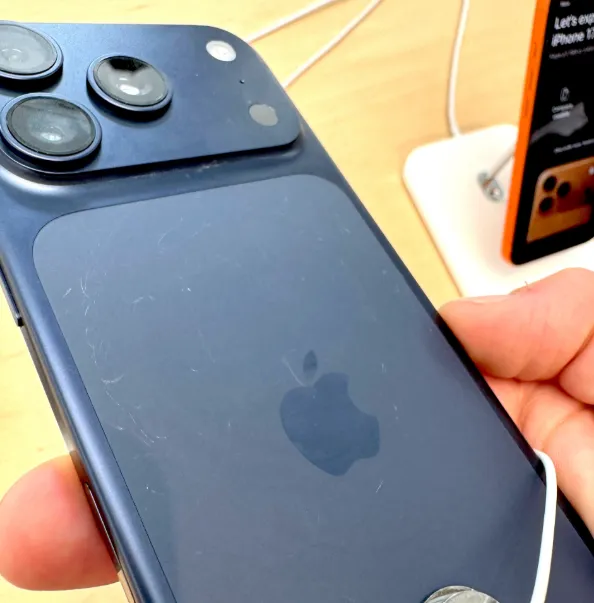Apple’s newest flagship, the iPhone 17, is once again in the spotlight—this time for concerns that go beyond its technical features. Not long after the launch, early buyers began reporting that their devices appeared to scratch too easily. Photos of blemished phones began spreading on social media, and durability testers on YouTube amplified the story with videos showing marks appearing under everyday conditions. The online buzz quickly earned the issue the nickname “scratchgate.”
Apple’s Response to Customer Complaints
Apple has moved quickly to calm the debate. The company insists that many of the marks people are noticing, particularly on display models in Apple Stores, are not true scratches in the aluminum or glass. Instead, Apple says these blemishes are the result of “material transfer” caused by repeated contact with MagSafe display stands. Essentially, the friction from the stands leaves behind residue that can look like scratches but can actually be wiped off. To address this, Apple has begun updating its in-store displays to reduce the chance of further confusion.
Focus on the Camera Bump
While Apple’s explanation covers display units, the discussion hasn’t ended there. Independent reviewers, including the well-known YouTuber JerryRigEverything, highlighted concerns with the raised camera module design. His tests showed that the edges surrounding the dual-camera housing—sometimes referred to as the “plateau”—could be scratched with relatively soft materials, such as a coin. iFixit’s teardown further noted that Apple’s anodized coating, designed for aesthetics and added strength, may be more prone to flaking when subjected to this type of wear.
Apple maintains that its internal testing is rigorous and that the iPhone 17 passed durability checks before release. Company representatives have also emphasized that no consumer device can remain flawless under all circumstances, and that real-world usage is far less punishing than deliberate stress tests performed for online content.
The Gap Between Testing and Reality
Part of the controversy comes down to expectations. Online stress tests are designed to push devices to extremes, often using sharp objects, coins, or keys to see how easily marks appear. Apple argues that these conditions don’t reflect the way most people actually treat their phones. However, the criticism has been harder to dismiss when consumers point out that retail units—handled daily by thousands of shoppers—already show noticeable signs of wear. For many, this suggests that the iPhone 17 may be more delicate than earlier models, or at least more vulnerable in specific areas like the camera bump.
A Broader Perspective on Scratches
It’s worth remembering that scratches and scuffs are nothing new in the smartphone world. Every generation of devices, from budget to premium, eventually shows the physical signs of daily handling. While protective cases and screen shields can extend the pristine look of a new phone, no product is completely immune. Apple has openly acknowledged this reality, stating that minor imperfections are simply part of a phone’s lifecycle.
Balancing Innovation and Durability
The iPhone 17 brings with it new design refinements and features, but these innovations often come with trade-offs. Slimmer edges, layered finishes, and more prominent camera modules create fresh aesthetic appeal while potentially introducing new points of vulnerability. For Apple, the challenge lies not only in building durable hardware but also in managing consumer expectations in a world where every flaw can be magnified online.
Ultimately, “scratchgate” reflects the modern relationship between technology companies and their customers. Consumers want sleek, lightweight, and cutting-edge devices, but they also expect them to withstand daily wear without showing visible damage. Apple’s defense suggests that the iPhone 17 is no more fragile than its predecessors, but with social media amplifying every complaint, the company may need to do more to convince buyers.
